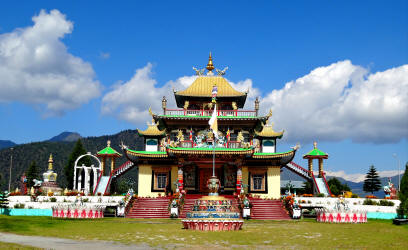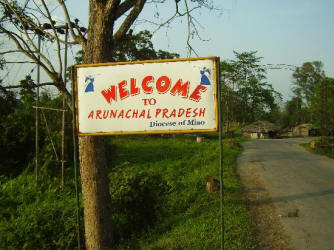|
Arunachal Pradesh is a state of
India. Located in northeast India, Arunachal
Pradesh borders the states of Assam and Nagaland
to the south, and shares international borders
with Bhutan in the west, Myanmar in the east and
the People's Republic of China (PRC) in the
north. Itanagar is the capital of the state.
Arunachal Pradesh means "land of the dawn-lit
mountains". Literally it means "land of the
rising sun" (Sanskrit: Arun: Sun, Pradesh:
state, province or region) in reference to its
position as the easternmost state of India. It
is also known as the "Orchid State of India" and
the "Paradise of the Botanists".It is the
biggest among the group of eastern states which
are commonly known as Seven Sisters. |

 |
|
 Like
other parts of Northeast India, a majority of
the people native to the state are of
Tibeto-Burman origin. A large and increasing
number of migrants have reached Arunachal
Pradesh from many other parts of India, although
no reliable population count of the migrant
population has been conducted, and percentage
estimates of total population accordingly vary
widely. Part of the Ledo Burma Road, which was a
lifeline to China during World War II, passes
through the eastern part of the state. Like
other parts of Northeast India, a majority of
the people native to the state are of
Tibeto-Burman origin. A large and increasing
number of migrants have reached Arunachal
Pradesh from many other parts of India, although
no reliable population count of the migrant
population has been conducted, and percentage
estimates of total population accordingly vary
widely. Part of the Ledo Burma Road, which was a
lifeline to China during World War II, passes
through the eastern part of the state.
The northern border of Arunachal Pradesh follows
the McMahon Line, a border delineated in the
Shimla Accord that was signed by the United
Kingdom and Tibet in 1914 but not by China (as
Tibet was not Chinese-controlled at that time).
China claims the northern portion of Arunachal
Pradesh as part of south Tibet. Arunachal
Pradesh is the Indian state which has the
largest number of regional languages.
Geography
Arunachal Pradesh is located between 26.28° N
and 29.30° N latitude and 91.20° E and 97.30° E
longitude and has 83,743 square kilometre area.
Much of Arunachal Pradesh is covered by the
Himalayas. However, parts of Lohit, Changlang
and Tirap are covered by the Patkai hills.
Kangto, Nyegi Kangsang, the main Gorichen peak
and the Eastern Gorichen peak are some of the
highest peaks in this region of the Himalayas.
The land is mostly mountainous with the
Himalayan ranges running north south. These
divide the state into five river valleys: the
Kameng, the Subansiri, the Siang, the Lohit and
the Tirap. All these are fed by snow from the
Himalayas and countless rivers and rivulets. The
mightiest of these rivers is Siang, called the
Tsangpa in Tibet, which becomes the Brahmaputra
after it is joined by the Dibang and the Lohit
in the plains of Assam.
At the lowest elevations, essentially at
Arunachal Pradesh's border with Assam, are
Brahmaputra Valley semi-evergreen forests. Much
of the state, including the Himalayan foothills
and the Patkai hills, are home to Eastern
Himalayan broadleaf forests. Toward the northern
border with Tibet, with increasing elevation,
come a mixture of Eastern and Northeastern
Himalayan subalpine conifer forests followed by
Eastern Himalayan alpine shrub and meadows and
ultimately rock and ice on the highest peaks.
The Himalayan ranges that extend up to the
eastern Arunachal separate it from Tibet. The
ranges extend toward Nagaland, and form a
boundary between India and Burma in Changlang
and Tirap district, acting as a natural barrier
called Patkai Bum Hills. They are low mountains
compared to the Greater Himalayas.
Transport
Air
 The state's airports are Daporijo Airport, Ziro
Airport, Along Airport, Tezu Airport and
Pasighat Airport. However, owing to the rough
terrain, these airports are small and are not in
operation. Before the state was connected by
roads, these airstrips were originally used for
the transportation of food. A green-field
airport serving Itanagar is being planned at
Holongi at a cost of Rs. 6.50 billion. The state's airports are Daporijo Airport, Ziro
Airport, Along Airport, Tezu Airport and
Pasighat Airport. However, owing to the rough
terrain, these airports are small and are not in
operation. Before the state was connected by
roads, these airstrips were originally used for
the transportation of food. A green-field
airport serving Itanagar is being planned at
Holongi at a cost of Rs. 6.50 billion.
Roads
Arunachal Pradesh has two highways: the 336 km
National Highway 52, completed in 1998, which
connects Jonai with Dirak, and another highway,
which connects Tezpur in Assam with Tawang. As
of 2007, every village has been connected by
road thanks to funding provided by the central
government. Every small town has its own bus
station and daily bus services are available.
All places are connected to Assam, which has
increased trading activity. An additional
National Highway is being constructed following
the Stillwell Ledo Road, which connects Ledo in
Assam to Jairampur in Arunachal.
Railway
Arunachal Pradesh has no railway line. It will
get its first railway line in late 2013 when the
new link line from Harmuti on the main Rangpara
North-Murkong Selak railway line to Naharlagun
in Arunachal Pradesh is commissioned. The
construction of the 33 km long 1,676 mm (5 ft 6
in) broad gauge railway link has been completed
in 2012 and the link will become operational
when the gauge conversion of the main line under
Project Unigauge is commissioned. The state
capital Itanagar is 10 km from the new railhead
Naharlagun. The new railway line will connect
Itanagar with the Indian railway network.
Source :
Wikipedia |